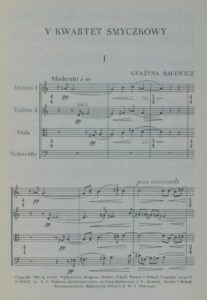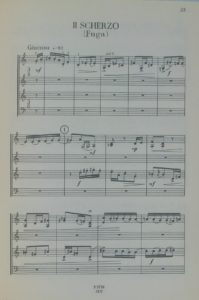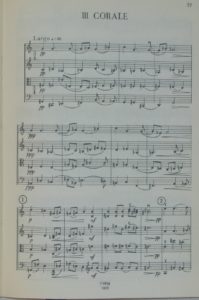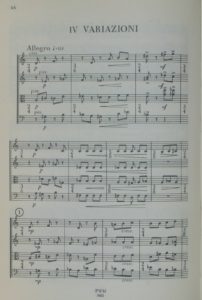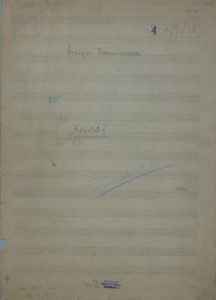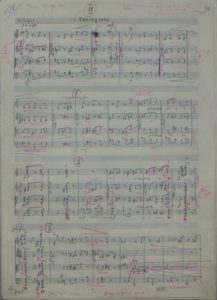- String Quartet no. 5, PWM score, mov. 1
- String Quartet no. 5, PWM score, mov. 2
- String Quartet no. 5, PWM score, mov. 3
- String Quartet no. 5, PWM score, mov. 4
In 1955 Grażyna Bacewicz composed String Quartet No. 5. In the following year she entered it for the String Quartet Competition in Liège, Belgium, where in 1951 she had received the 1st Prize for her String Quartet No. 4. This time her quartet came second. Many scholars, including Mieczysław Tomaszewski and Adrian Thomas, claim that the order should be the other way round, because in their view Quartet No. 5 is more mature than its predecessor. The opinion is debatable. The piece is simply different, certainly more hermetic, hence is smaller popularity than that of its predecessor, which also has a jazz version arranged by Krzysztof Herdzin.
String Quartet No. 5 consists of four movements. Like many other of the composer’s pieces, the first movement (Moderato) begins with a small initial (embryonic) motif – a descending second in the first violin, repeated in an ascending version in the other instruments. Out of this tiny cell there emerge other motifs making up a dramaturgical whole achieving the status of the first theme. The procedure resembles the similar “becoming” of the first theme in String Quartet No. 1 – not as a homogenous melodic idea, but a mosaic of motifs united as an energy continuum. Unlike in Quartet No. 4, this initial cell is not part of the introduction but an integral part of the first theme, which – owing to its structure – is better described as the first theme group. This thematic group is literally repeated in the reprise, with the figure comprising a descending second and its inversion ending the whole movement. However, the overall structure of the sonata allegro with two themes is preserved, but the way the sound material is used is very different from neoclassical models, if only because of its textural diversity – interweaving of polyphonic sequences with homophonic and chordal sequences, as well as wealth of colours. This is clearly seen in the second theme, folk in its spirit, the melodic distinctiveness of which disappears in an extravaganza of flageolets, repeated figures played arco and pizzicato, tremolandos and trills.
The second movement (Scherzo) is a two-theme, atonal fugue with two expositions and a range of transformations, canonical in this form, like inversions of the thematic motifs, as well as multiplicity of colour effects. The fugue is written in spite of the seriousness of the form, as it were – the very first theme, lively and in 3/8 to be played giocoso, suggests its dance origins. The exposition of the second theme is preceded by quite humorous glissandos, while the second theme, in 2/4, is “keyboard” rather than string in its nature. In the development both themes are played in a uniform metre of 3/8.
An energetic Scherzo is followed by a serious Corale (third movement) in the ABA1 form, played largo and in the metre of 3/4. A simple, regular theme presented in the first violin and brining to mind folk music, is accompanied by a counterpoint of the other voices, the melodic lines of which blur the original harmonic sense of the main theme. The middle fragment, which is not without a dose of pathos, features elements of imitation.
The fourth movement (Variazioni) consists of a theme, six variations and a coda. The amelodic theme, played pizzicato, leads to textural variations differing in nature. Particularly interesting is the first variation, the core of which comprises quasi-glissando runs of parallel fifths in the second violin (and then also in the first violin), decorated with flageolets and pizzicatos of the other instruments. In his article “Aspecte der Klangfarbe in den Werken der letzten Schaffensperiode Grażyna Bacewiczs (1960–69)” [Łódź 1996], Stefen Wittig describes this phenomenon as a signal of transformations of interval structures into values of pure movement and colour. The whole is summed up by a coda beginning with a quasi-imitation and closing the whole with a series of strong chords played pizzicato and sforzato.
String Quartet No. 5 testifies to a continuous evolution of the composer’s sound language, with the old formal principles remaining largely preserved. Bacewicz’s practical knowledge of the technical possibilities of string instruments combined with her colour imagination enabled her to create a type of narrative frequently shaped by the changeability of sound forms.
- String Quartet no. 5, manuscript, (Music Department, Warsaw University Library), title page
- String Quartet no. 5, manuscript, (Music Department, Warsaw University Library), mov. 1 (excerpt)
- String Quartet no. 5, manuscript, (Music Department, Warsaw University Library), mov. 4 (excerpt)
